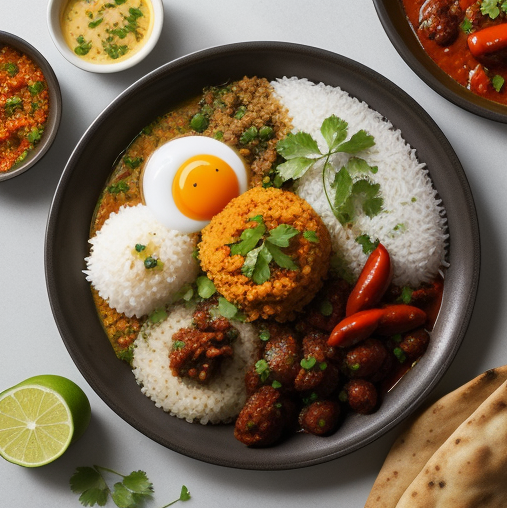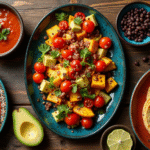 Middle Eastern cooking is like a vibrant tapestry, woven with rich aromas and complex flavors that tell a story of centuries-old traditions and cultures. This region’s cuisine is a beautiful blend of Mediterranean, Persian, and Central Asian influences, creating a unique and enticing flavor profile that’s hard to resist.
Middle Eastern cooking is like a vibrant tapestry, woven with rich aromas and complex flavors that tell a story of centuries-old traditions and cultures. This region’s cuisine is a beautiful blend of Mediterranean, Persian, and Central Asian influences, creating a unique and enticing flavor profile that’s hard to resist.
The essence of Middle Eastern food lies in its balance between earthy, tangy, spicy, and savory notes. It’s a culinary adventure where fresh herbs, zesty citrus, and bold spices come together to form dishes that are as diverse as the people themselves.
Spices play a starring role in this cuisine, not just for flavor but also for their aroma and color. They’re sprinkled generously and used wisely to enhance the natural taste of fresh ingredients, producing an unforgettable dining experience.
When we talk about the Middle Eastern flavor profile, we’re talking about a symphony. Think of the earthiness from cumin and coriander, the citrus kick from sumac, and the aromatic warmth from cinnamon and cardamom. These elements create a complexity that dances on your palate, leaving you craving more.
The Magic of Middle Eastern Spices: Taking Taste to Another Level

Spices are the soul of Middle Eastern cuisine, transforming simple ingredients into unforgettable meals. Imagine your taste buds traveling from the earthy whispers of cumin to the sweet notes of cinnamon, with a spicy detour courtesy of sumac, paprika, or chili.
Let’s demystify a few stars of the spice rack. Sumac, a reddish-purple powder, brings a tangy zest, perfect for brightening up meats and salads. Then, there’s za’atar, a blend with thyme, sesame seeds, and sumac, adding depth to breads and veggies. Turmeric gives food a golden glow and a mild bitterness, often teamed with cumin and coriander for a robust flavor blend.
Saffron might be the most luxurious of them all, with its subtle honey-like sweetness that can turn a dish from ordinary to extraordinary. A pinch of this can transform rice, meats, and even desserts into aromatic wonders.
Now, how do we sprinkle some Middle Eastern magic into our kitchens? Start by incorporating these spices into your regular recipes. Try adding a dash of cumin when roasting vegetables or mix za’atar with olive oil for a delicious bread dip. The key is to experiment, adjust, and enjoy the flavors as they unfold.
Culinary Journey Through Whole Foods: Discovering Middle Eastern Ingredients

Whole Foods, owned by Amazon, is like a treasure trove for anyone keen to explore the flavorful palette of Middle Eastern cuisine, offering a diverse selection of authentic ingredients.
From the aisles filled with aromatic spices to the bulk bins brimming with grains like bulgur and couscous, Whole Foods makes these once exotic staples effortlessly accessible.
Grab a bag of lentils to start crafting a comforting bowl of red lentil soup, or pick up some chickpeas for a creamy homemade hummus. The options are endless and all within reach.
What sets Whole Foods apart is its commitment to quality and freshness, ensuring that each ingredient holds the potential for authentic taste experiences.
Chatting with other culinary adventurers, many have found Whole Foods’ Middle Eastern section not just a shopping destination but a source of inspiration. The mix of traditional and innovative ingredients can spark creativity in both experienced chefs and home cooks alike.
Tips and Tricks: Bringing Middle Eastern Flavors to Your Kitchen
Bringing Middle Eastern flavors into your kitchen is easier than you might think, and it starts with a few simple recipes and some adventurous spirit. Imagine turning your everyday dishes into something extraordinary with just the right touch of Middle Eastern flair.
Start with falafel, those crispy, golden balls of seasoned chickpeas. Homemade, they’re a revelation: crispy on the outside, warm and fragrant on the inside. Pair them with some tahini sauce and fresh veggies, and you’ve got yourself a delightful treat.
Don’t shy away from trying your hand at making tabbouleh—a refreshing salad with finely chopped parsley, mint, tomatoes, onions, and a drizzle of olive oil and lemon juice. It’s a burst of freshness that complements just about any main dish.
When it comes to spices, proper storage is key. Keep spices in a cool, dark place, preferably in airtight containers, to maintain their potency. A well-stocked spice drawer is a gateway to culinary adventures, inviting you to explore and experiment with blends.
To really embrace the Middle Eastern vibe, consider building a pantry around staple ingredients like olive oil, pomegranate molasses, preserved lemons, and labneh. Each one offers its own unique twist to your dishes, opening new dimensions of flavor and texture.
With these ingredients on hand, you can turn a simple bowl of rice into a fragrant pilaf or elevate grilled meats with a marinade packed with Middle Eastern zest. It’s all about exploring and trusting your taste buds to guide you to deliciousness.




I absolutely love eating Middle Eastern foods! Just looking at the image on this post makes me hungry. 🙂 I am not the greatest chef in the world though so I often shy away from making it. I have a favorite restaurant that I will go to about once a month. I would like to have these meals more often though so I am going to look into some recipes. Do you have any suggestions for an online resource or cook book for Middle Eastern cooking?
A very interesting website and article about Middle Eastern Flavors. I am not really very familiar with this or whole foods but I know I should be. I like to try new things. Trying new recipes, new restaurants, and new stores, is right down my ally. I noticed your article mentioned seasoned chickpeas called Falafel. That sounds interesting. I heard that chickpeas are good for low carb diet. Do you recommend a recipe for Falafel? Also, I tried a brand-new recipe recently for chicken soup and it called for couscous noodles. I had no idea what that was. I googled and found it was a kind of noodle in the shape of little balls. I purchased a container of them and used them in the soup. What other kids of dishes can I use couscous in?
Thank you for your comment. You can use couscous in a variety of ways. Try it in salads or as a base for other meals. You can even use it in your baking.